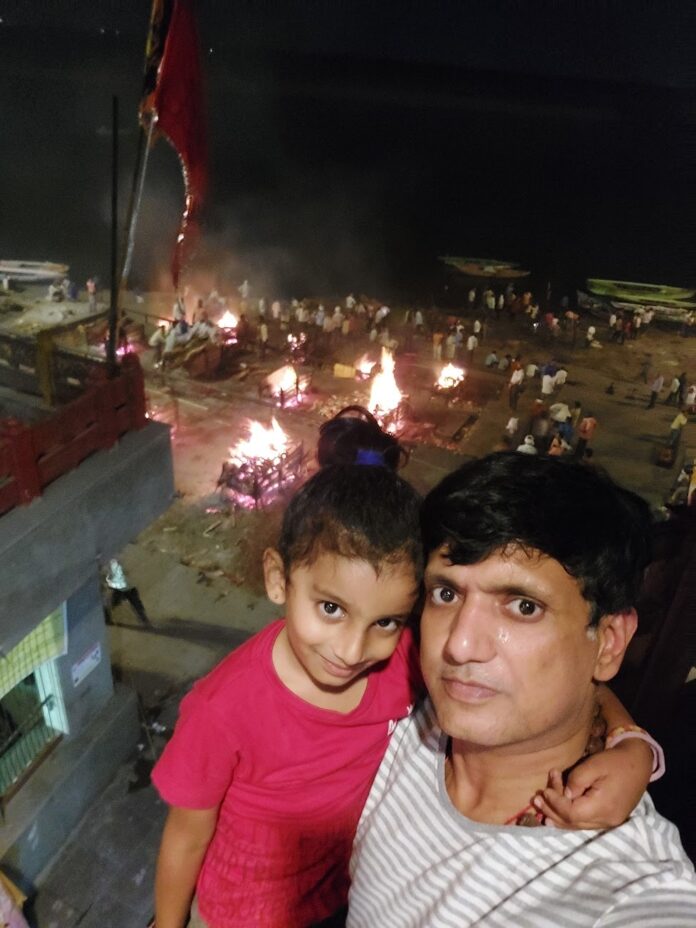The one thing which profoundly impacted me is when I saw what death means in Kashi. At Manikarnika Ghat, it’s explained how death is to be celebrated as if it’s birth.
Some things which I understood and got to know from Manikarnika Ghat are as follows:
1. It is the oldest ghat and is mentioned in a 5th-century Gupta inscription.
2. Traditionally, the ghat is named after Mata Sati’s earrings which fell there. It is a Shakti Peeth where Sati’s ear ornament fell (hence the name Manikarnika).
3.. It is believed that Lord Shiva himself directs the soul of the dead to the path of salvation by speaking the ‘Taraka Mantra’ in the ears of the dead.
4. Those who get cremated here are liberated from the cycle of life. It is considered the holiest cremation ground among Hindus.
My objective is not to refer to काश्यां मरणं मुक्तिः or from Vishnu Purana: “अन्तकाले च मामेव स्मरन् मुक्त्वा कलेवरम् | यः प्रयाति स मद्भावं याति नास्त्यत्र संशयः”.
Also, here in the north, we usually say ॐ शान्तिः शान्तिः शान्तिः (which is not uncommon), but more pervasive is “Ram naam Satya hai.” I was even surprised when I saw cremation in Uttarakhand where it’s “Ram naam Satya hai, Shambo Shankara.”
The idea of this article is to propose a salutation that has more meaning and serves as a replacement to “RiP.” This phrase, “Rest in Peace,” RIPS me apart. Along with this, I wanted to write about the importance of karma kriya and the importance of cremation within 24 hours, the stages of the soul’s journey, and the rituals associated with it, simplifying it for our people.
I also want to discuss the differences or lack thereof between cremation and burial and why it varies in different sampradayas of our dharma. Additionally, nowadays, I don’t see anyone using the umbilical cord (connected from the navel of the person who gives fire to the departed soul) during cremation. This symbolizes the birth and how it’s disconnected during birth and why we do this during cremation or burial.
Saarthak with His Father at Manikarnika Ghat ( मणिकर्णिका घाट)
Why Atma Paramatma Advaya Namah ? Why in my view its meaningful ?
When someone leaves this world, many might say “Rest in Peace” (RiP). However, in the profound tradition of Sanatana Dharma, we find a more meaningful expression of our sentiments: “Atma Paramatma Advaya Namah.”
“Atma Paramatma Advaya Namah” is the closest equivalent to the essence of “तत्त्वमसि” (Tat Tvam Asi) and the teachings of Bhagavad Gita 18.61 and Mundaka Upanishad 3.2.9.
Advaya (अद्वय) means non-duality, which directly corresponds to the core concept of “Tat Tvam Asi” (You are that), indicating the oneness of the individual soul (Atma) with the Supreme Soul (Paramatma or Brahman).
Here’s why this is fitting:
Tat Tvam Asi (Chandogya Upanishad 6.8.7):
This Mahavakya (great saying) from the Chandogya Upanishad is one of the four principal Mahavakyas in the Upanishadic texts. It translates to “You are that,” asserting the essential identity of the individual soul (Atma) with the ultimate reality (Brahman).
Chandogya Upanishad 6.8.7:
Sanskrit: “स य एषोऽणिमैदमात्म्यमिदं सर्वं तत्सत्यं स आत्मा तत्त्वमसि श्वेतकेतो” (Sa ya eṣo’ṇimaitadamātmyamidaṁ sarvaṁ tatsatyaṁ sa ātmā tattvamasi śvetaketo)
Translation: “That which is the finest essence—this whole world has that as its soul. That is Reality. That is the Self (Atma). That art thou (Tat Tvam Asi), Śvetaketu.”
This profound teaching emphasizes that the essence of all beings and the universe is the same as the essence of the individual self. Recognizing this unity leads to liberation and the realization of one’s true nature.
Bhagavad Gita 18.61:
In the Bhagavad Gita, Lord Krishna explains the presence of the Supreme Soul (Ishvara) in the hearts of all beings. This verse suggests an intrinsic unity between the individual souls and the Supreme.
Sanskrit: “ईश्वरः सर्वभूतानां हृद्देशेऽर्जुन तिष्ठति। भ्रामयन्सर्वभूतानि यन्त्रारूढानि मायया॥” (Īśvaraḥ sarva-bhūtānāṁ hṛd-deśe’rjuna tiṣṭhati bhrāmayan sarva-bhūtāni yantrārūḍhāni māyayā)
Translation: “The Lord dwells in the hearts of all beings, O Arjuna, and by His illusive power, causes all beings to revolve as if mounted on a machine.”
This verse underscores the intimate connection between the individual soul and the Supreme Soul, suggesting that all actions and lives are guided by the divine presence within.
Mundaka Upanishad 3.2.9:
The Mundaka Upanishad speaks about realizing Brahman (the Supreme Soul) hidden in the heart, which leads to experiencing all desires in unity with the omniscient Brahman.
Sanskrit: “यो ह वेद निहितं गुहायां परमं व्योमन्। सोऽश्नुते सर्वान् कामान् सह ब्रह्मणा विपश्चितेति॥” (Yo ha veda nihitam guhayam paramam vyoman sa’shnute sarvan kaman saha brahmana vipashchiteti)
Translation: “He who knows that highest Brahman hidden in the cave of the heart, enjoys all desires along with the all-knowing Brahman.”
This verse highlights the unity of the individual soul with the Supreme Soul and the bliss that comes from realizing this unity.
“Atma Paramatma Advaya Namah” salutes the non-dual nature of the Atma and Paramatma, aligning well with these profound concepts from ancient texts.
A Celebration of the Soul’s Journey
As we reflect on the departure of a loved one, we are reminded of the transient nature of our existence on earth. Life is temporary, and each of us is here to fulfill a unique purpose. When that purpose is served, we return to our divine origin. In the words of the Thirukkural, “அகிலாத எல்லாம் அகலும், முகில்தவழ் வானம் வரயிலா வாறே” (All that is assembled shall one day disband, just as the clouds in the sky, when laden, pour down and scatter) [Thirukkural 131]. This reminds us of the impermanence of life and the inevitable return to our source.
Let us celebrate the departure of the soul, for it is a reunion with the Supreme Soul, a return to our eternal home. The departed soul goes back to meet all those beloved who have left before, and one day, we too will reunite with them.
Until that day, we bid farewell to our dear one with love and reverence. May their journey be filled with peace and light, as they merge into the infinite embrace of Paramatma.
“ஆத்மா பரமாத்மா ஒன்றாய் உணர்த்தும் வணக்கம்” “Ātmā paramātmā oṉṟāy uṇarttum vaṇakkam” (Salutations to the realization of the oneness of the soul with the Supreme Soul).
Atma Paramatma Advaya Namah
Balaji Krishnammagaru.


